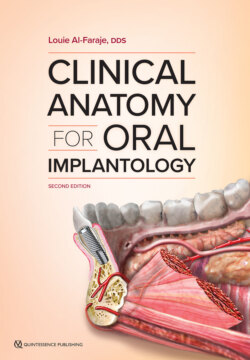Читать книгу Clinical Anatomy for Oral Implantology - Louie Al-Faraje - Страница 18
На сайте Литреса книга снята с продажи.
Maxillary nerve (CN V2)
ОглавлениеThe maxillary nerve (Fig 1-11a) is the second branch of the fifth cranial nerve (trigeminal nerve). Its function is the transmission of sensory fibers from the maxillary teeth, the nasal cavity, the sinuses, and the skin between the palpebral fissure and the mouth (Figs 1-11b and 1-11c). In the cranium, the maxillary nerve branches off into the middle meningeal nerve, then passes through the foramen rotundum into the pterygopalatine fossa, where it divides into the zygomatic nerve, the ganglionic branches (pterygopalatine branches), and the infraorbital nerve.
FIG 1-11 (a) The maxillary nerve. n.—nerve; CN V1—ophthalmic nerve; CN V3—mandibular nerve. (b) Region of skin supplied by the maxillary nerve. (c) Innervation of the maxilla along the recommended anesthesia technique per area.
The zygomatic nerve passes through the inferior orbital fissure and gives branches of sensory fibers to the lacrimal nerve, then divides into the zygomaticotemporal branch (temple) and the zygomaticofacial branch (for the skin over the zygomatic arch).
The ganglionic branches are nasal branches (nasopalatine branches) that pass through the sphenopalatine foramen into the nasal cavity, the palatine nerves (greater and lesser) for the soft and hard palates, and the pharyngeal nerve, which provides sensory supply to the upper pharynx.
The infraorbital nerve enters the orbit through the inferior orbital fissure (after branching off into the posterior superior alveolar nerves to the molars and the medial superior alveolar nerves); it traverses the infraorbital groove and canal in the floor of the orbit, where it branches off into the anterior superior alveolar nerve, and appears on the face at the infraorbital foramen. Here it is referred to as the infraorbital nerve, a terminal branch. At its termination, the nerve lies beneath the quadratus labii superioris and divides into several branches that innervate the side of the nose, the lower eyelid (inferior palpebral nerve), and the upper lip (the superior labial nerve), joining with filaments of the facial nerve.
